|
This small Japanese garage kit maker released an incredible kit of the Ferrari
F1-2000. The kit is made out of white metal, but it is not a 1/43 kit, it is a big 1/12 kit! There is a long time since Tamiya released their last 1/12 scale F1 kit (which I consider the ultimate category in F1 modeling).
Needless to say the F1-2000 which brought Ferrari the drivers championship after a drought of 21 years, I really think that this model deserved a 1/12 scale rendition of it. Its design was clearly different from other McLaren resembling machines, and one of the best-looking among the current F1 racing cars.
Fortunately, we have the Tamiya kit in 1/20 (nice kit in 1/20, the major scale of F1 model, but a lot of
modeler must be longing for that memorial machine in 1/12.) Japanese garage kit maker Museum Collection, previously released the Ferrari 412T2 and Mercedes 300SL transporter, with good quality, has just released the F1 2000.
As far as I know, this is the first 1/12 F1 kit made in white metal. Though, the metal is clearly better than resin in respect of deformation, it is easily imagined that there were a lot of difficulties for a
small maker. First of all, it is a very expensive kit, but even cost, I want praise
Museum Collection for its challenging spirit.
The Kit
As described above, most of the parts are cast in white metal. The monocoque, floor pan, diffuser, wings, front wing endplates, flaps, wheels, steering wheel and suspension arms, etc. are metal. The engine, exhaust pipes and seat are resin parts; plus, photo etched parts for the rear wing endplates etc, rubber tires, satin ribbon for seat belts, vacuum formed parts as well as screws and nuts for wheels.
The kit also includes the Hi-tech decal that doesn't leave any varnish layer The decal sheets include complete Marlboro logos. First of all, I want to say that I was overwhelmed by the sight of all those BIG metal parts; this is my first experience with a kit of such size in metal. The casting of those parts was very sharp and accurate, compared with other resin kits.
Thanks to the metallic nature of the materials, the edges of flaps and diffuser etc. can be
finished very thin. The engine cowling is removable, as well as the fuel cover. Furthermore, Museum Collection plans to release a set of extra parts for the Malaysian and Italian GP, which includes an engine cowling, a nose section, and the front. We can change those parts after we finish building. But to enjoy these
gimmicks, a great deal of effort will be needed as I describe later. Some of those metal parts should be "glued" with solder and some skill of soldering will be needed.
|
Body
The main body is made out of the monocoque, nose cone, engine cowling, induction
pod, and the floorpan. For this review, first of all, I tried to fit these parts. The fitting was poor, especially the monocoque did not fall into place on the floorpan, so I needed to scrape both parts.
The cowling didn't fit either with the monocoque and the floorpan; so I had to adjust the
separation line for the cowling. I wonder if I can put the rear suspension within the cowling in future work.
Due to the lack of adjusting in these parts, they need to be fixed temporally and correct the surface with the putty, even if you plan to open the cowling section. The maker said these poor fitting is due to an individual difference. This may be the limit of garage kit that use rubber for the molds. Anyway, in order to make the cowling removable, or changing the parts of other GP, as I've described above, a well-thought-out plan will be needed.
To
build this kit, it is very important to keep in mind that the fitting of the parts is crucial. After the hard work, and when the kit came into full view, I realized that all my work was worth the effort.
The final appearance is great, it perfectly reproduces the refined and slender shape of the real F1-2000. The designer of Museum collection may have the marvelous skill of reproducing F1 machine in 1/12, just as he did with his previous work, the 412T2.
|

|

|

|

|
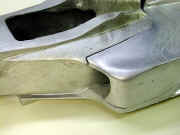
|
|
Wings
All wings are made out of metal and are well made. Though the front wing
is integrated with the flap, the thin main wing and the link between wing and
flap are noteworthy. The complicated shape of the endplate, is built up with etching
parts.
The diffuser and barge-boads are metal, so the builder can easily finish them as thin as he wants. For the rear endplate, metal parts and etching brass parts are included. Metal parts are a better material for the bottom of the endplate, due to its complex forms in the real car. The metal main and lower wing and flaps are very realistic.
|
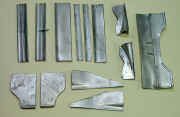
|

|
|
Suspension
Suspension arms are made out of metal, and have a very delicate finishe. The bases for the
arms, in the monocoque, are a good point to show the builder's skill. Recent
machines use very thin plate spring for this parts and are directly connected to the monocoque.
Rear suspension arms, gold and silver heat-resistant are striking. The kit
includes metal sheet and it comes with a paper pattern for this.
|
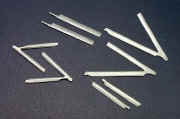
|
|
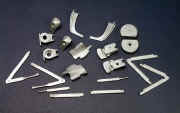
|
Engine
Unexpectedly, the engine and exhaust pipes are made out of resin. I think these
are the very parts that should have been made out of metal. The maker said that the parts
like exhaust pipe shape, are very difficult to make with metal. The builder
should make an effort to represent the burning metal when using these parts.
The oil cooler is metal but you must shorten its height because it interferes with the cowl, as described in the instruction sheet. The pipes and other mechanical parts around the engine and radiator are omitted; the builder must make these parts out from scratch materials, if he wants the full-detail.
|
Tires
The tires are made in good quality rubber, but have problems about their size.
Though, from 1999, the diameter for the front and rear tires became the same, the
front tire in the kit is smaller than the rear tire, and the rear tire diameter is
also small. Because of this, the photos of the finished model on the maker's
web site gives the impression that the clearance between front wing and
front tire is a little big. Moreover, the separation between the grooves is too wide,
especially in the rear tires. As the rubber parts of tires are most difficult to
scratch or to modify, I regretted these problems. The tire's logos are represented very realistic by means of the Hi-tech decal. Wheels are well made metal parts.
|

|
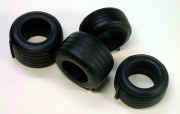
|
Cockpit
The seat and its surroundings are cast in a single resin part. The kit includes the
ribbons for the seat belts and good metal parts for the buckles. The steering
wheel is metal and well detailed. If you are careful with the materials for the seat, the inner parts of the monocoque and the protectors, you will get a wonderful cockpit.
|
Decals and construction sheet
The decal which includes the Marlboro logos, is a Hi-tech decal which is one of the strongest points in the Museum collection line. After applying the decals to the model, the clear layer can be removed and only the paint layer will be remain. With a knack you
can get a wonderful result. (About this technique, see Mario's report for the 412T2).
This Hi-tech decal will be effective especially for 1/12 scale model. The construction sheet is not an ordinary manual with numbered steps on the building sequence; it only explains the difficult steps to build. They may think that their model is intended for expert modelers only; practical tips will be more useful than simple composition drawings. I think that in order to build this kit, this explanations are not enough, even for experts.
At least, the composition drawings with parts list and the photos of of the finished model, would be necessary. The builder must observe all parts carefully and make a trial fit for the building.
|
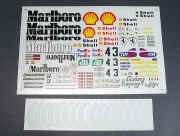
|
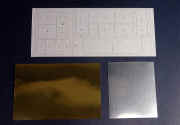
|
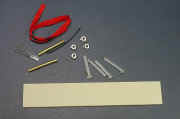
|
Conclusion
When building this kit, the builders may be a little bit amazed in some steps, because
this kind of big metal kit is really unfamiliar.
But, compared with other 1/12-resin kit, this kit is not very hard to build.
Thanks to the metal, all edges of the parts can be thinned, and the model will look more real than a resin model. However, soldering is necessary for the building because the kit is very heavy, so the builder need some experience in soldering.
As described above, you must pay attention whenever you lift the cowl section, so you will not peel off the paint on the edges; believe me, it is an almost impossible task. My recommendation is to fix the cowl and leave it in place, which fully represents the beautiful lines of the real car, or put it aside and add the detailing around the engine section and the rear suspension.
Anyway, for the modeler with some level of skill, this kit will provide the greatest F1-2000 miniature. The basic form of the kit is good, so the more work the builder puts on, the better the model will become, it is worth the hard work.
After all, we are talking about the Ferrari's memorial championship machine, and in 1/12 scale!
The finished model will be a precious art craft in your collection.
|